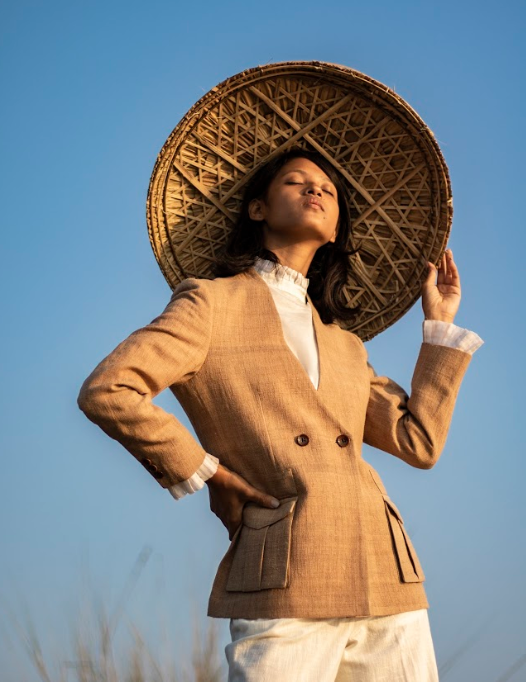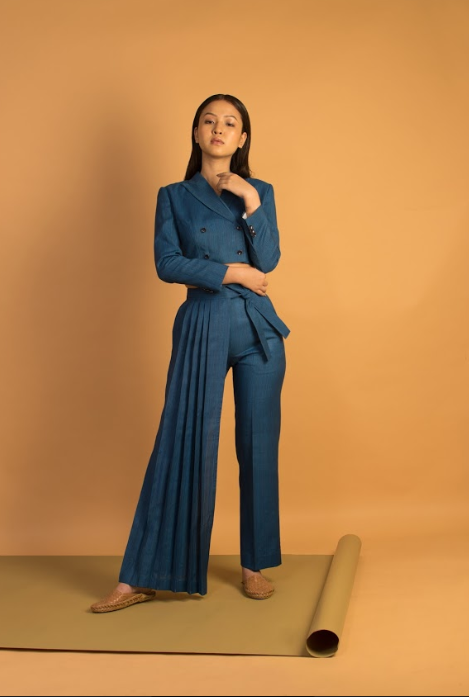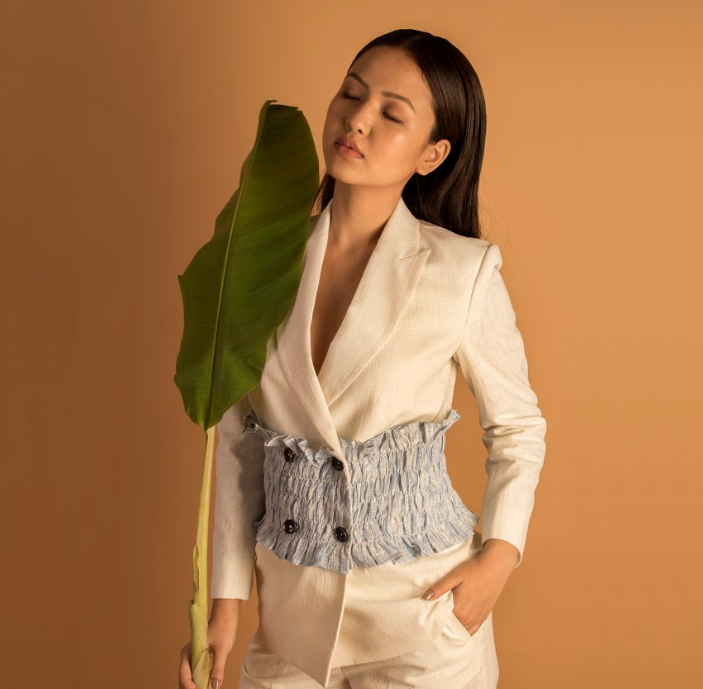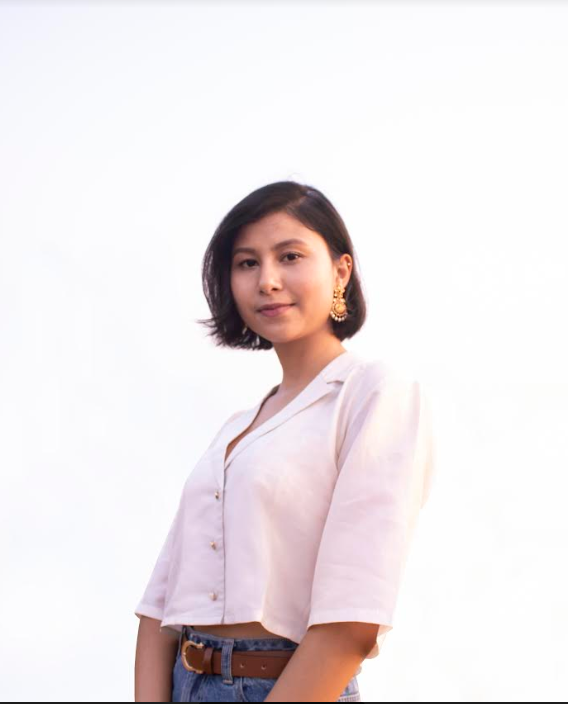Ura Maku is a sustainable clothing brand that is looking to rebuild Indian handlooms with an eco-friendly fashionable twist.
The brain child behind contemporary natural fabrics label Ura Maku, Designer Manjushree Saikia, Textile Design graduate from NIFT Mumbai is all about freedom of expression. Incidentally Ura Maku as a brand is all about giving the wearer wings to fly high and yet be rooted in their culture. She tells us all about her design philosophy in this exclusive conversation.

TELL US SOMETHING ABOUT YOUR EARLY DAYS AND IF FASHION DESIGNING WAS ALWAYS AN AREA OF INTEREST?
Hailing from upper valleys of Assam, I have grown up with Assamese textiles and folk cultures. My maternal side family are Vaishnava devotees while paternal side are Bodo tribals and being close to both the sides I have realized how even being Assamese, cultural practices, food and dressing beliefs vary and are yet connected by a common thread. Curiosity about cultures and craft drew me close to textiles and later I got introduced to fashion. Though design college taught me a lot, witnessing different craft clusters of India taught me about the need to be responsible towards textiles. My paternal grandmother was the niece of a famous Assamese artist called Kalaguru Bishnu Prasad Rabha and she was an artist as well. My family believes that my passion for art and fashion comes from her.
WHEN AND WHY DID YOU START URA MAKU?
After my Graduation from NIFT as a textile designer, I started travelling and visiting craft clusters across India from Bhuj in Gujrat to Bhagalpur in Bihar. I was stunned by their skilled hand craftiness and more than that their humbleness and values made me realize the responsibility and thoughtfulness that a designer must have towards craftsmanship and Indian artisans. The product making process is as important as much as being mindful towards humanity. In 2017, I started Ura Maku that is an ode to the sustainable movement of clothing.
THE NAME URA MAKU MEANS FLYING HIGH? WHAT WAS YOUR THOUGHT PROCESS BEHIND THE SAME?
In Assamese, Ura means to fly and Maku is the shuttle in weaving. Shuttle is a crucial part in weaving and textiles and plays an important role. We believe that without textiles, fashion would be mere an imagination. Ura Maku is the story of every person who dares to fly high yet are rooted to their cultural values. Ura means fly and defines our timeless power suits and tailored clothes while Maku means shuttle and represents the handwoven and handcrafted textiles of India

WHY DID YOU DECIDE TO HAVE A SUSTAINABLE LABEL?
As we are learning about sustainability every day, it is a vast topic of concern as well as a movement. Fashion has always been a revolution and I believe is an expression of own self. Any movement begins with you and Ura Maku is an extension of my design self. I believe in this fast-growing world, we are compromising our crafts, environment and future. It is time that we are mindful of what we are doing and try to revive the indigenous crafts and artisans of India. The core of sustainability lies in our villages. A lot of time, rural belief and myths also have a scientific story. While sustainability is a broad topic, my label tries to cover few ideologies which includes eco-friendly fabrics, organic dyeing ethical work culture, hand weaving, promoting the artisans of India and timeless and slow fashion.
WHO OR WHAT INSPIRES YOU?
The folk culture, artisans and my roots inspires me the most. The North East of India has many sub-tribes and is very rich in culture. Though their textile speaks diverse languages, I draw the minimalistic approach from them and believe that ‘less is more’. I believe we do not need a lot in our life and all we really need is what defines us and the story behind that which we can strongly connect with. As I draw inspiration from the historical evidences of fashion for the silhouette, every movement in the past has come up with some revolution in people’s lifestyle and the way they express themselves through their dressing. From clothing as a necessity to gender fluid fashion, we have come a long way.
YOUR COLLECTIONS HAVE INTERESTING NAMES TELL US MORE.
Our creations are timeless and regardless of any season and trend. The collection names therefore speak the mindset of our muse which is beyond trends and seasons unlike most fast fashion retail brands. With time, our muse who we design for is growing with her/his progressive mindset. They are aware of today’s scenario and have strong rightful voice for the society and the globe.
WHICH HAS BEEN THE MOST CHALLENGING COLLECTION TO DATE AND WHY?
The very first collection was the most challenging one. I had so much in my mind but to convert those ideas into reality was a task. My biggest fear was what if I was unable to do justice in creating my ideologies and values into my clothes.
TELL US ABOUT YOUR EXPERIENCE AT THE LAKME FASHION WEEK?
Being a ‘Gen Next’ winner itself was an overwhelming feeling. It was a great experience and being mentored by and work with best experts in the industry was something to cherish. The Lakme fashion week debut was incredible and gave us a new reach. The response to the show amazed us and overall it was a huge learning to cherish for lifetime.

WHAT ARE SOME FASHION TRENDS YOU SEE IN 2020?
I do not believe in trends as it fades away with time. Classic is not time driven and is always in. With social media and blogging and following up with new trends, fast fashion is still at its peak. While there was a time when brands used to follow only two seasons Spring-Summer and Autumn-Winter, now fast fashion brands produce about 52 micro-seasons a year. That means one new collection every week. We are dealing with ‘climate change’ already. How do we challenge the environment more? I see vintage fashion, thrifted and retail come to the forefront in 2020 which I personally appreciate. Reusing and minimising your wardrobe with only few thoughtful pieces is being smart and I hope this awareness comes to people.
TELL US ABOUT THE FABRICS YOU ARE WORKING ON REVIVING AND HOW YOU GO ABOUT IT?
We have been working on many conscious fabrics and are trying to revive Assam textiles majorly and especially Eri Silk which is found in North Eastern part of India. This is a wild silk that is also known as peace silk and is vegan, cultivated and handspun into coarser yarns that makes it durable. Popular machine-made artificial fabrics are competing with slow fashion. The natural fabrics are high maintenance and therefore its higher cost is making it less relevant to the current consumers. We are also working on Muga silk, known as golden silk which is produced only in Assam and has a Geographical Indication of Assam. Muga is a wild silk and the worm mostly feeds on Som trees. Muga silkworms needs more care than any other and the climatic condition needs to be proper to grow them in Som farm called ‘sumoni’. Time and quality labour makes it the most expensive silk and hence pure authentic Muga is rare to find. If designers like us start working on such pure indigenous crafts, as long as we respect and honour these crafts, artisans will be empowered. We are trying to promote them through our creations by sharing awareness about these fibres, their properties and significances.
WHAT IS THE USP OF YOUR CLOTHES?
Ura Maku is not just a label, it is a part of sustainable movement to revive handlooms of India yet our design creations are modern tailored focuses on attention to details. We are eco friendly as all the fibres we use are all organic/natural. We are handcrafted as right from cultivation of fibres to hand spinning, hand wearing to tailoring all is hand done. Our tailored fabrics are high quality constructions that give attention to detail. All our fabrics are organic dyed and I tea dye by myself and are timeless and are not trend/season driven.
WHAT ARE YOUR FUTURE PLANS?
We believe in slow and steady growth as like our brand ideology. We are honored and blessed to have reached where we are now.
This story first appeared in Apparel Magazine’s March 2020 issue here:
